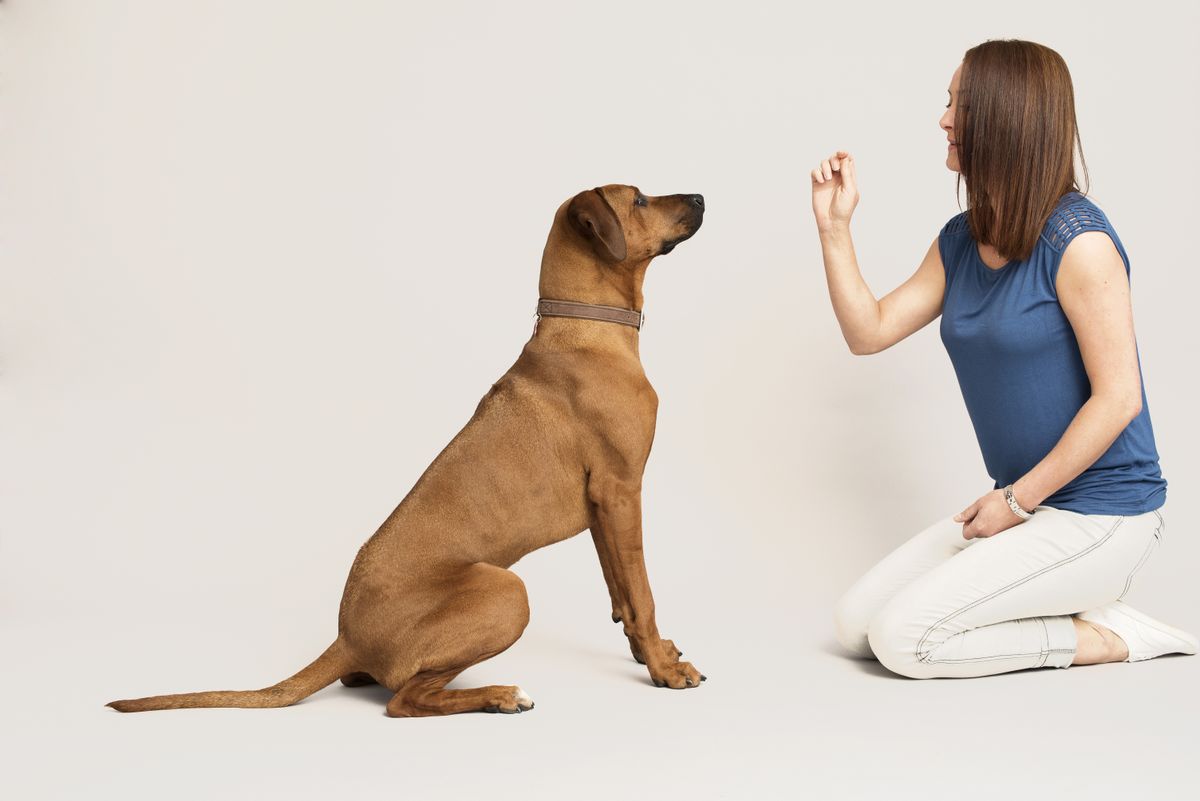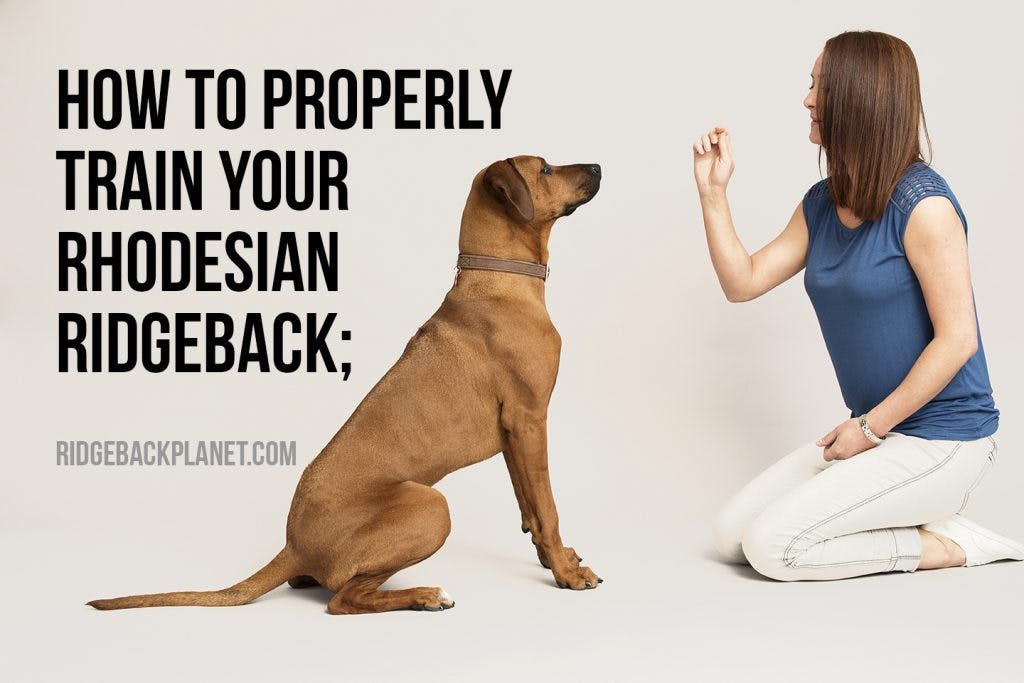10 Most Effective Tips for Properly Training Your Rhodesian Ridgeback

You’re asking yourself how do I stop my puppy from nipping at my ankles, chewing up my shoes, and pooping and peeing all over my house? Read on to find out more.

So, you have just brought your Rhodesian Ridgeback puppy home. You’ve played with him, you’ve cuddled him, you’ve made him part of the family! But now you’re discovering that not all his traits are wonderful and adorable and you’re wondering what to do! You’re asking yourself how do I stop him from nipping at my ankles, chewing up my shoes, and pooping and peeing all over my house?
The answer to these questions is to give your Rhodesian Ridgeback some structured and productive training; to teach them right from wrong. To help you in this essential, but sometimes difficult and frustrating task, here are our ten most effective tips.
10 Effective Tips To Use In Order To Train Your Rhodesian Ridgeback Properly
1. Always remember that you have chosen a Rhodesian Ridgeback!
Chances are you chose a Rhodesian Ridgeback because they are a faithful, affectionate, fun, easygoing, and athletic breed. However, you also need to recognize that they are stubborn and independent and rarely like being told what to do. Rhodesian Ridgebacks are not the easiest breed to train and you need to take this into account when trying to do so and remain firm but fair at all times.
2. Recognize All learning Is A Building Block
Just as with children, a Rhodesian Ridgeback puppies learning is incremental with each technique being learned to build on a previously learned behavior. Simple commands lead to more complex commands and reinforce learning. It is advisable to remember that canines, as children again, do not learn instantly and may need their training repeated frequently at first.
3. Choose An Environment That Is Conducive To Learning
I don’t know about you but I’m quite easily distracted from what I’m supposed to be doing by outside influences. The same goes for Rhodesian Ridgeback puppies, who will easily lose interest in training if they see something else that interests them. For that reason, training should be given in a place and at a time that they can focus on what you are teaching. Busier environments will need to be introduced later once the desired behavior has been instilled.
4. Vary The Times Of Day Training Takes Place
Your Rhodesian Ridgeback puppy will not be guaranteed to be susceptible to training at the same time every day. Their moods, behavior, and attention span will vary at different times making periodic training the way to go. Puppies also do not have the ability to concentrate for very long so keep your sessions five to ten minutes long.
5. Know Which Behaviors To Concentrate On First
Cutting to the chase social behaviors, alongside toilet training, should be the first things you teach to your Rhodesian Ridgeback. These include behaviors such as not jumping up, sit, stay, heel, going to a location on demand, and staying away from places like the dinner table. Combining verbal and physical actions within training will get the best results. For example, should you want your puppy to sit, simply give the command, push your puppies bottom to the floor, smile, praise, and reward.
You will also need, and this is highly important, to teach your Rhodesian Ridgeback to be sociable. They are not naturally inclined to be so and can be aloof and standoffish with strangers. To avoid this, introduce them to as many people as you can and also other animals. Rhodesian Ridgebacks have a predatory instinct and will need to learn not to chase. Failure to implement social training can lead to aggression.
6. Treat Toilet Training As A Separate Form Of Training
It will hardly come as a surprise that toilet training cannot be done during a training session. After all, your puppy does not just want to poop or pee during these times. Rather, they will go to the toilet at various times through the day and night, so training is pretty much 24/7.
7. Acknowledge Your Rhodesian Ridgeback Wants You Happy
Despite being independent and stubborn a Rhodesian Ridgeback will want nothing more than to keep you happy. Therefore, though they can be difficult at times, they will usually be ready and eager to learn. This is aided by the fact that dogs are like absorbent sponges when it comes to learning, making training, hopefully, progress with ease.
8. Use Positive Not Negative Reinforcement
Rhodesian Ridgebacks really do not like being shouted at or being shown harsh reinforcement. Rather, you should concentrate on keeping all training sessions positive and show excitement and pleasure when they get things right. It probably doesn’t need to be said, but I’m going to say it anyway, you should never physically reprimand your Rhodesian Ridgeback no matter what.
9. Take Advantage Of Tools Available At Your Disposal
As with most breeds of dog, food is a very powerful motivator for the Rhodesian Ridgeback. You will be incredibly unlucky to find one that will not learn the correct behavior in exchange for a tasty treat.
10. Don’t Take Too Much Advantage Of The Tools Available
It would be unfeasible to think that it is prudent or possible to give your Rhodesian Ridgeback a treat for every command it obeys for the rest of their life. Not only would this prove to be very expensive, but it would also be very costly for your dog’s health. Treats equal calories, which in too high a number can lead to obesity. Rather, you should slowly wean your dog off receiving a treat for wanted behavior, and get them to accept positive reinforcement instead.
Why Train Your Rhodesian Ridgeback?
If you’re thinking that there’s a lot to take on board when it comes to tips for training your Rhodesian Ridgeback, you’d be right. However, if because of that you’re thinking of not bothering, then please think again. Rhodesian Ridgebacks are a whole lot of dog to handle, especially if left to run riot and as they please.
If you need some examples of behaviors you can expect from an untrained Rhodesian Ridgeback they are as follows:
- Stealing food when you are not looking
- Running away off leash
- Digging up plants
- Ripping up floors
- Chasing people and other animals
- Nipping at your feet and ankles
- Jumping up
- Chewing shoes, dog beds, furniture; despite having toys of their own
- Annoying neighbors with barking and whining
- Pooping and peeing all over the house
- Showing aggression
After reading those, I’m sure you’ll agree that an untrained and unruly Rhodesian Ridgeback is the last thing that you want. Rather, you would prefer to have a well-behaved and sociable dog that it would be a pleasure to take and welcome anywhere.
As well as appropriate behavior learning, training your Rhodesian Ridgeback can also:
- Strengthen the bond between owner and dog.
- Help communication skills grow between owner and dog.
- Be fun for both the dog and the family.
- Decrease/eliminate behavioral issues.
- Provide enrichment and stimulates your dog’s brain.
- Give your dog a job.
- Lessen the likelihood of your dog being surrendered to a shelter by you.
- Build confidence in shy and fearful dogs.
- Create less work for you in the long run.
- Enhance safety, and could even save your dog’s life.
Can I Get Help Training My Rhodesian Ridgeback?
Not everyone will find training their Rhodesian Ridgeback easy or be able to manage it all alone. It is nothing to be ashamed of, nor does it mean you are a bad owner. Rhodesian Ridgebacks can be notoriously difficult, as mentioned before, to train, and there is nothing wrong with seeking help.
There are two ways that you can train your Rhodesian Ridgeback by using help. These are by attending an assisted training class, or by employing an assisted private trainer. Both are equally as effective but you may wish to consider a private trainer to begin with if your puppy is very easily distracted or shows aggression to other dogs.
Beginner Assisted Training Class – It really doesn’t matter where you live there will be this type of class local to you. To find one simply enter puppy training followed by the area that you live into Google and voila, a plethora of options will appear.
At a training class, you can expect a number of owners all looking to instill good behaviors into their puppies. You will be taught the basic social behaviors we have looked at before with the advantage of also socializing your pup.
Assisted Private Trainer – Again these are easy to find if you do a Google search. Most private trainers will attend you and your puppies education within your own home, relatively few will ask you to go to them.
Advantages include that your puppy will not be distracted by other dogs whilst learning and that your trainer can concentrate on areas of difficulty specific to your Rhodesian Ridgeback. Private training will not, however, help with socialization, so you’ll have to take care of that alone.
Further Training For Advanced Rhodesian Ridgebacks
Many people opt to stop training their Rhodesian Ridgebacks once they have completed basic training, and that’s perfectly fine. However, there are more training options out there should you wish to pursue them. This is often a great idea when it comes to Rhodesian Ridgebacks since they need to be stimulated on a regular basis and can become bored, and destructive, when not.
Advanced training can take many forms but they all have one thing in common. They are about having fun with your dog whilst teaching them something new and keeping them occupied. Teaching them tricks is a great example of advanced training and the options and possibilities with this are endless. Rolling over, playing dead, commando crawling, giving a paw, covering eyes with paws, and standing on hind legs are all great common examples.
Less common advanced training, but gaining popularity quickly, is agility. This kind of training is high energy, addictive, and engaging, and will keep both you and your Rhodesian Ridgeback fit. It will also appeal to your dog’s natural instincts of running and chasing perfectly and surprisingly is not that expensive to set up.
As a beginner to this form of training, there are a few pieces of essential equipment which you can buy or make yourself. These include:
- Weave Poles – A set of six to twelves poles that are inserted into the ground and your Rhodesian Ridgeback will weave in and out of.
- Teeter Totter – A seesaw but wide enough that your dog walks/runs across it.
- Jump – Basically similar to the jumps you see at equestrian events but lower and simpler construction.
- Tunnel – A flexible, usually tough canvas, tunnel that can be positioned in a straight line or curved for your Rhodesian Ridgeback to run through.
You may want to consider making, rather than buying, these pieces of equipment yourself as it can be cheaper. However, it is also worth checking out auction sites like eBay for second hand and inexpensive pieces that could work out cheaper.
If you don’t want to buy the equipment at all or want to try agility before you buy there are classes springing up all over the country. Many of these are also linked to or can direct you to agility competitions should your Rhodesian Ridgeback really have the knack.
It is also worth mentioning at this point that many of the tips provided for basic training also apply here. Your Rhodesian Ridgeback, for example, may not pick up agility or tricks straight away and may require time. They will also not respond well to, and should never receive negative reinforcement. Advanced training is, as mentioned before, meant to be fun, and should be kept that way.
Is There Any Training Unsuitable For Rhodesian Ridgebacks?
What I am about to say may well sound very contradictory, but it’s not. Rather, it is sound advice to prevent your Rhodesian Ridgeback from becoming overly aggressive. Rhodesian Ridgebacks make great guard dogs, but they should never be trained as such!
There is no doubting that Rhodesian Ridgebacks make exceptionally good guard dogs. They are loyal, protective, do not bark without good cause, and almost always make it on to any top ten guard dog lists. This is due to their history of being used as hunting and protection dogs and being bred specifically for those jobs.
Introduced into Rhodesia in 1887, the Rhodesian Ridgeback was used as a guard and protection dog due to its natural bravery and immense tenacity. So brave, in fact, was this breed that they even herded and kept lions at bay for their owners. They were not, however; it is worth pointing out, at any time used to actually kill them.
Fast forward to the 1950s and the Rhodesian Ridgeback was being introduced to the American public. Many people were immediately enamored by them and over time they were welcomed into homes as family pets. This is not surprising since they display highly desirable qualities along with staggeringly handsome good looks.
However, and herein lies the point, the Rhodesian Ridgeback has never lost its chasing, hunting, or guarding instincts. Fantastic, when it comes to being a natural guard dog. Terrible, when it comes to receiving guard dog training!
Why? Because further training them to guard will only increase their guarding behavior. They may even cross the line into severe aggression and potentially attacking. This is not, definitely not, 100% not, behavior that you want to encourage in your Rhodesian Ridgeback. Especially when they are perfectly good guard dogs without interference.
Training Yourself For A Rhodesian Ridgeback
Last, but certainly not least, it is absolutely worth mentioning that you yourself have a responsibility to obtain some training in regard to owning a Rhodesian Ridgeback. Of course, this doesn’t mean that you have to learn to sit and stay or walk at heel, but you do need to educate yourself on this dog breed and its needs.
Research, research, and more research is the key to successful training in this case. You should read everything and anything you can about the wonderful Rhodesian Ridgeback and then read a little bit more.
The main areas to research in order to ensure you have all the correct and needed knowledge/training before you welcome a Rhodesian Ridgeback into your home include:
- Knowing the breed inside and out
- Locating a responsible and respected breeder
- Potential health problems
- What kind of diet they need
- What training they will need (covered above)
- Are they suitable for your family/home
- What the potential costs are of ownership
- Have you got the time for such a breed
Main Takeaways For Rhodesian Ridgeback Training
- Basic training is essential for Rhodesian Ridgebacks
- Training is best and most effective when given to a puppy
- Rhodesian Ridgebacks are not the easiest breed to train
- Rhodesian Ridgebacks do not respond well to negative reinforcement
- Untrained Rhodesian Ridgebacks will run rings around you
- Advanced training is fun and beneficial for a Rhodesian Ridgeback and you
- Rhodesian Ridgebacks should never receive guard dog training
- As a Rhodesian Ridgeback owner, you need some training too



